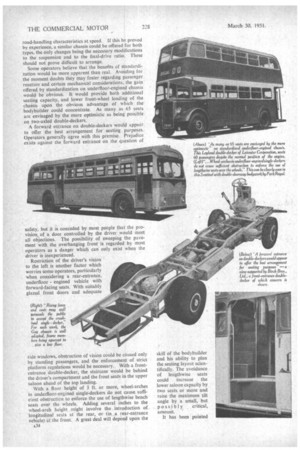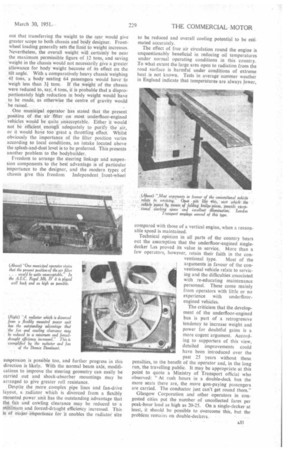Fresh Fields
Page 43

Page 44

Page 45

If you've noticed an error in this article please click here to report it so we can fix it.
for Underfloor
Engines
By
P. A. C. BROCKINGTON, A.I.M ech.E.
MANY maintenance and service advantages, as yet unobtainable, it seems, would be assured by the operation of a fleet of singleand doubledeck buses based fundamentally on the same chassis with the same power unit, frame, transmission components and wheelbase dimensions. Operators are not unanimous in their opinions on the crush-load single-decker versus the high-capacity double-decker . controversy, The prospect of standardization could, however, influence both those who have already made up their minds in favour of one or the other type and those who think of economy in terms of a mixed fleet with varied duties.
One manufacturer, at least, is confident that the tilt test does not present a major problem in the design of the underfloor-engined doubledecker provided that the overall width of the engine can be reduced to within the normal flywheel diameter of 20 ins. Fitting a flat engine would then entail raising the floor height from 2 ft. 4 ins, to approximately 2 ft. 8 ins., the increased height of the centre of gravity being partly offset by the lower position of the power unit. The main difficulty of building an engine within the flywheel diameter is created by the necessity of levelling-out the contour of the timing case. Modifications necessary to achieve this could raise auxiliary-drive difficulties, but these should not prove unsurmountable.
The effect of the higher floor in relation to the potential increase in seating capacity and the gross laden weight of the vehicle would depend upon the skill of the bodybuilder and the latitude he has in choosing materials. If a serious sacrifice has to be made to compromise the extra 4 ins., the floor-height problem could almost certainly be overcome by employing a two-stroke power unit.
The possibility of reducing the wheelbase of underfloor-engined single-deckers to that of double-deckers without surrendering their suitability for standard and 30-ft. bodies would be of utmost value in promoting standardization. By moving the engine to the rear, the polar moment of inertia of the singledeck chassis would be reduced and the gain in naanceuvrabdity need not be at the expense Of road-handling characteristics at speed. If this be probed by experience, a similar chassis could be offered for both types, the only changes being the necessary modifications to the suspension and to the final-drive ratio. These should not prove difficult to arrange.
Some operators believe that the benefits of standardization would be more apparent than real. Avoiding for the moment doubts they may foster regarding passenger reaction and certain mechanical considerations, the gain offered by standardization on underfloor-engined chassis would be obvious. It would provide both additional seating capacity, and lower front-wheel loading of the chassis upon the obvious advantage of which the bodybuilder could concentrate. As many as 65 seats are envisaged by the more optimistic as being possible on two-axled double-deckers.
A forward entrance on double-deckers would appear to offer the best arrangement for seating purposes. Operators generally agree with this premise. Prejudice exists against the forward entrance on the question of safety, but it is conceded by most people that the provision of a door controlled by the driver would meet all objections. The possibility of sweeping the pavement with the overhanging front is regarded by most operators as a danger which can only exist when the driver is inexperienced.
Restriction of the driver's vision to the left is another factor which worries some operators, particularly when considering a rear-entrance, underfloor engined vehicle with forward-facing seats. With suitably glazed front doors and adequate side windows, obstruction of vision could be caused only by standing passengers, and the enforcement of strict platform regulations would be necessary. With a frontentrance double-decker, the staircase would be behind the driver's compartment and the front seats in the upper saloon ahead of the top landing.
With a floor height of 3 ft. or more, wheel-arches in underfloor-engined single-deckers do not cause sufficient obstruction to enforce the use of lengthwise bench seats over the wheels. Adding several inches to the wheel-arch height might involve the introduction of.. longitudinal seals at the rear, or (in a rear-entrance vehicle) at the front. A great deal will depend upon the A34 out that transferring the weight to the rear would give greater scope to both chassis and body designer. Frontwheel loading generally sets the limit to weight increases. Nevertheless, the overall weight will certainly be near the maximum permissible figure of 12 tons, and saving weight in the chassis would not necessarily give a greater allowance for body weight because of its effect on the tilt angle. With a comparatively heavy chassis weighing 41 tons, "a body seating 64 passengers would have to weigh less than 31 tops. If the weight of the chassis were reduced to, say, 4 tons, it is probable that a disproportionately high reduction in body weight would have to be made, as otherwise the centre of gravity would be raised.. •
One munieipal operator has stated that the present position of the air filter on most underfloor-engined vehicles would be quite .unacceptable.. Either it would not be efficient, enough' adequately to purify -the air, or it would have too great a throttling effect. Whilst obviously the importance of the filter position varies according to local conditions, an intake located above the splash-and-dust level is to be preferred. This presents another problem to the bodybuilder.
Freedom to arrange the steering linkage and suspension components to the best advantage is of particular importance to the designer, and the modern types of chassis give this freedom. Independent front-wheel suspension is possible too, and further progress in this direction is likely. With the normal beam axle, modifications to improve the steering geometry can easily be carried out and shock-absorber mountings may be arranged to give greater roll resistance.
Despite, the more complex pipe lines and fan-drive layout, a radiator which is divorced from a flexibly mounted power .unit has the outstanding advantage that the fah and cowling Clearance may be reduced to' • a thitiInium.and forced-draught efficiency increased. This iff *Major iMporfance for it enables the radiator Mkt
to be reduced and overall cooling potential to be esti. mated accurately.
The effect of free air circulation round the engine is unquestionably beneficial in reducing oil temperatures under normal operating conditions in this country. To what extent the large area open to radiation from the road surface is harmful under conditions of extreme heat is not known. Tests in average summer weather in England indicate that temperatures. are always lower, compared with those of a vertical engine, when a reasonable speed is maintained.
Technical opinion in all parts of the country bears out the assumption that the underfloor-engined singledecker has proved its value in service. More than a few operators, however, retain their faith in the con ventional type. Most of the arguments in favour of the conventional vehicle relate to servicing and the difficulties associated with re-educating maintenance personnel. These come mainly from operators with little or no experience with underfloorengined vehicles.
The criticism that the development of the underfloor-engined bus is part of a retrogressive tendency to increase weight and power for doubtful gains is a more cogent argument. According to supporters of this view, detailed improvements could have been introduced over the past 25 years without these penalties, to the benefit of the operator and, in the long run, the travelling public. It may be appropriate at this point to quote a Ministry of Transport official who observed: "At rush hours in a double-deck bus the more seats there are, the more yon-paying passengers are carried. The conductor just can't get round them."
Glasgow Corporation and other operators in congested cities put the number of uncollected fares per peak-hour load as high as 20-25. On a single-decker at least, it should be possible to overcome this, but the problem remains on double-deckers.












































































